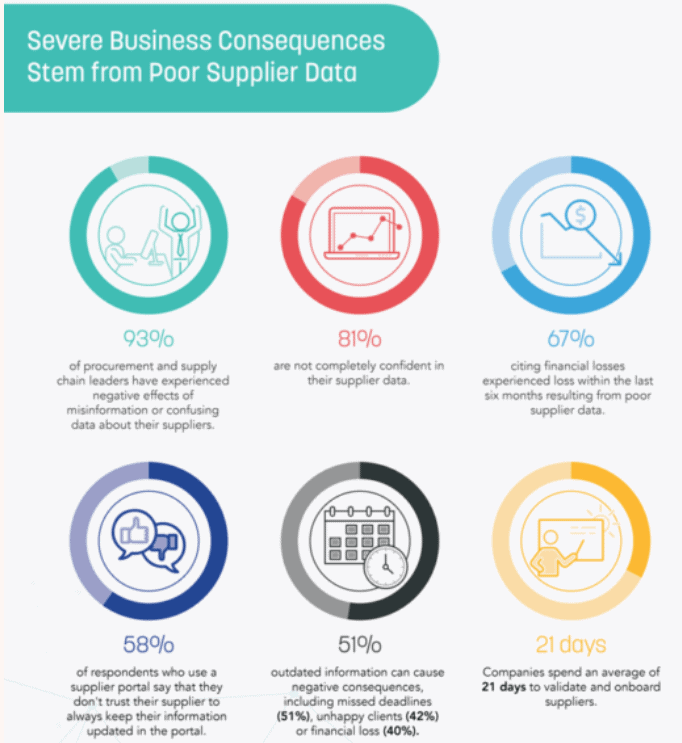All organisations are dependent on their suppliers. No matter how streamlined your own operations are, if your suppliers don’t produce the desired quantity of quality goods on time, every time, sooner or later you’re going to fail to deliver to your customers – and it’s you who will feel the cost. Out of stock items, long order delays, missed opportunities and deadlines – poor performing suppliers are often the root cause of them all.
As such, it’s essential for organisations to establish an efficient mechanism to measure, analyse and manage the performance of their suppliers – a practice known as supplier performance management (SPM).
What Is Supplier Performance Management?
Put simply, supplier performance management is the process of evaluating the performance of your suppliers in order to cut costs, mitigate risks in the supply chain and drive continuous improvement.
Through careful analysis and comparison of supplier performance, organisations can ensure and maintain the best service possible from their suppliers – and eliminate those that fail to meet expected standards and performance requirements.
In addition, supplier performance management provides the basis for organisations to manage and improve strategic supplier relationships. When supplier performance is tracked, analysed and communicated with suppliers, those same suppliers gain a better understanding of your organisation’s precise needs and expectations. Performance gaps can be identified and actions can be outlined to achieve desired performance levels.
Ultimately, the objective of supplier performance management is to identify the root cause of any issues in the supply chain, solve problems quickly and improve supplier performance to the benefit of all parties involved in a contract.
Improving Supplier Performance
Supplier improvement is one of the most important business practices an organisation can embark upon. If a supplier is failing to meet your standards or the expectations defined in the contract, you need business processes in place to remedy the issue as quickly as possible.
However, in order to improve the performance of your suppliers, you must first look inwards towards your own supplier performance management processes. Often, supplier improvement begins with the actions you take within your own organisation.
Here are some tips on how to improve supplier performance with better supplier performance management.
Communicate Clearly with Your Suppliers – And Formalise All Agreements in Writing
Effective supplier performance management begins by ensuring your suppliers understand your specific needs and requirements. If you want your supplier to meet your expectations, it’s imperative that those expectations are clearly defined in a formal, written agreement – including how supplier performance will be measured and managed. While verbal agreements are often relied upon to close deals quickly, the only way to ensure accountability later on and drive supplier improvement is with a written contract.
It’s important, however, that you communicate regularly with suppliers and take responsibility for your own role in the relationship. Your suppliers, of course, have their own business objectives that they are trying to achieve.
If you, for example, repeatedly place orders that require emergency handling, frequently change orders after placing them or are slow to pay your suppliers, you will likely limit their willingness or even ability to maximise performance.
Empower your suppliers to enhance their performance in every way you can. Share information with them in a timely fashion if you are looking to increase orders, pay them on time and ask your suppliers what they need from you to ensure they can always deliver.
Measure Supplier Performance
You can’t manage what you can’t measure. In terms of supplier performance management, you need to identify key performance indicators (KPIs) by which you can measure supplier performance and quantify improvement.
Again, it’s important to communicate to your suppliers what your supplier KPIs are and which metrics specifically you will be measuring. If you let your suppliers know, for example, that you will be tracking delivery in full and on time (DIFOT) percentages and will be reporting those metrics, it’s highly likely that you will see those metrics improve.
Another important KPI to track is quality. How consistently are the goods you order of the proper grade? How often is there an issue with inferior quality goods, the wrong goods being sent, or even missing goods from the order?
You may also consider including price, availability of goods and customer service in your list of supplier KPIs. Your choices should reflect the needs of your business. All metrics need to be recorded and reported regularly. Any performance issues that arise should be discussed quickly with your suppliers so problems can be solved as they are identified.
Ensure Supplier Data Is Accurate
As your stock needs replenishing from your suppliers, it’s crucial that you have accurate data of both your own inventory as well as your supplier lead times. If your usage increases, your stock levels may be inadequate – and without accurate supplier data, you run the risk of running out while you await replenishment.
A recent survey commissioned by big data company Tealbook found that poor supplier data is causing a huge number of critical issues for procurement organisations, including wasted time (63%), missed deadlines (51%), unhappy clients (42%), project delays (47%) and financial loss (40%). In all, 93% of procurement and supply chain leaders have experienced adverse effects of misinformation about their suppliers and 47% experience such negative effects on a regular basis.
(Image source: dcvelocity.com)

“Trusted supplier information is the most critical asset a procurement organization can possess,” said Matt Palackdharry, Vice President of Strategy at Tealbook. “This information is the fuel that powers all procurement technology, it influences billions of dollars of business decisions, and without it, organisations lose the ability to be agile when supply chains become overrun.”
Technology is indeed the answer to getting a better handle on supplier data. By implementing purpose-built tools that enable better information sharing with suppliers, not only does it become easier to monitor supplier performance, transparency between your organisation and your trading partners is greatly improved.
One of the best technologies in this regard is a rebate management system. Rebate management software is designed from the ground up to keep constant track of all transaction and supplier performance data. All agreements made with your suppliers are recorded and stored in the cloud for easy access, search, review and shareability.
In other words, rebate management software provides a centralised solution for drafting, reviewing and approving agreements with suppliers, with all sales and purchases made against those agreements automatically tracked and calculated.
In addition, a rebate management system provides robust analytics and reporting features that allow you to continuously evaluate the performance of your suppliers with accurate, up-to-the minute data – providing you with the insights you need to drive performance improvements and optimise your supply chain.
Want to learn more about how you can improve supplier performance management? Talk to our experts at e-bate today for more information or to request a demo of our data-driven rebate management solution.

